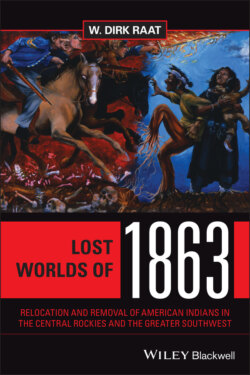Читать книгу Lost Worlds of 1863 - W. Dirk Raat - Страница 21
2 Numu (Paiute) Wanderings, Trails, and Tears
ОглавлениеIn 1863 Company G of the 2nd California Cavalry was sent to Owens Valley to reinforce fellow troopers assisting American settlers at war with Paiute Indians. On the way, the soldiers surrounded a Tubatulabal village near Keysville and killed 35 to 40 Indian men. On the return trip, the troops marched About 1,000 Paiutes to the Tejon Reserve, bringing 300 to the fort, which had been closed in 1861 … . Neither the Indian agent nor the military provided enough food to sustain the captives.
Office of Indian Affairs, San Francisco, July 11, 18641
You would make war upon the whites [taibo’s]. I ask you to pause and reflect. The white men are like the stars over your heads. You have wrongs, great wrongs, that rise up like the mountains before you; but can you, from the mountain tops reach and blot out those stars … . What hope is there for the Pah-Ute? From where is to come your guns, your powder, your lead, your dried meat to live upon, and hay to feed your ponies while you carry on this war. Your enemies have all of these things, more than they can use. They will come like the sand in a whirlwind and drive you from your homes.
Numaga (Young Winnemucca), Pyramid Lake Paiute, Indian Leader and Speaker, April 18602
This time he [Wovoka, Mason Valley, Nevada, Paiute and Initiator of Ghost Dance movement in 1887] hadn’t left his body to follow the shamans’ path under the earth or into the shadowy realm of animistic powers and magic; instead, he visited a monotheistic Heaven and spoke to a very Methodist-sounding God with strong Mormon leanings.
Gunard Solberg, Tales of Wovoka 3
The early 1860s was a time of turmoil and conflict for the Paiute peoples of Owens Valley east of the Sierra Nevada Mountains, as well as the Northern Paiutes of the Pyramid Lake region in what was then Utah Territory and present-day western Nevada. Even in eastern Nevada where the Overland Stage Company ran from Salt Lake City to the Schell Creek Mountains (immediately east of present-day Eli, Nevada), a distance of 225 miles, an eight-month war took place between the cousins of the Northern Paiutes, the Goshutes, and the white intruders. At least 16 whites were killed, and over 50 Goshutes died before peace was achieved in October 1863.4
These incidents and conflicts were followed by events that eventually led to the disintegration of the Paiute homeland and, of course, the Paiute sense of family and identity. The so-called Keyesville Massacre of 1863 resulted in the death of at least 35 Indians,5 including many Paiutes, and that event was followed by the removal of nearly a thousand Owens Valley Paiutes to Fort Tejon and the region of southern California. There many would succumb to measles and other “European” diseases.
The Pyramid Lake War of 1860 was followed by the Mud Lake Massacre of March 1865 when old men and women, as well as children and little babies, were burnt alive, including one of Chief Winnemucca’s wives, Tuboitony.6 The disintegration of the Pyramid Lake Reservation led these Northern Paiutes to wander from federal reservation to federal reservation, from army camp to army camp—first at Camp McDermit in northern Nevada, then the Malheur Reservation in Oregon, and after the Bannock War of 1878, to the Yakama Reservation beyond the Columbia River in Washington. The latter was a forced march that became, for the Paiutes, their own “Trail of Tears.”
After the Dawes Act of 1887 the Paiutes were to be given 160 acres on an individual basis for parcels of marginal land. Many received nothing, and instead they were forced to form small ghettos adjacent to white communities in hopes of doing odd and dirty jobs the white man or woman would not do. It is not surprising then that the ancient Ghost Dance Religion would be revived in hopes of restoring the traditional Paiute values of homeland, family, community, and identity—a heaven on earth that would exclude the white outsider.
